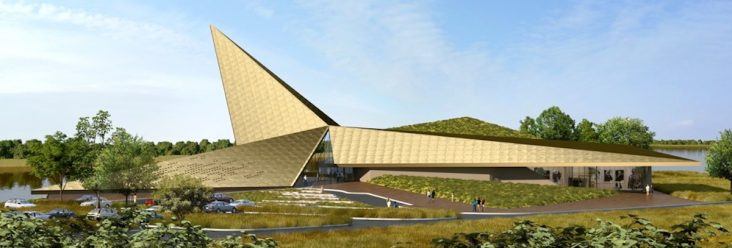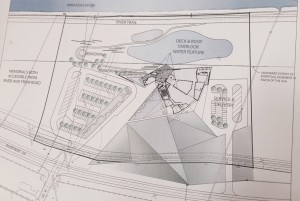New site layout for U.S. Marshals Museum, fundraising and other ‘next steps’ discussed
by December 8, 2015 9:18 pm 630 views

Previous artist rendering of U.S. Marshals Museum look. It is unclear how much the look may change once architects revise plans to fit a new site plan.
Members of the U.S. Marshals Museum Board heard Tuesday (Dec. 8) several key changes and plans, including a new site layout for the planned museum, next steps in the fundraising push, and the need for a person who may eventually be the first museum director.
While the core structure remains the same, the new site plan pulls the museum footprint away from the river’s edge, and incorporates a “water feature” over which a deck and a planned prominent roof spire will reach. A memorial recognizing the five civilized tribes settled in Oklahoma is planned for the south part of the museum footprint, with a trail to run from the front edge of the museum down to the Greg Smith Riverfront Trail now under construction along the Arkansas River.
Changes to the layout happened after a surprise easement revelation. In early 2014 it was learned the planned museum site near the Arkansas River in downtown Fort Smith may have to be changed because of an unknown easement issue. The problem arose when the Arkansas River navigation system was built and county real estate records were not property changed to reflect new easements. However, the U.S. Corps of Engineers agreed in early November to allow construction of the museum that crossed easement lines in some areas.
Jim Dunn, president and CEO of the U.S. Marshals Museum, announced Nov. 5 that the museum signed the agreement with the Corps that will allow work on the more than $50 million project on the 16.3-acre space donated by the Robbie Westphal family.
The new site plan also has the museum on a 10-foot base that moves the museum out of the 100-year flood line and into a 500-year line, according to Dunn.

MUSEUM BACKGROUND
In January 2007, the U.S. Marshals Service selected Fort Smith as the site for the estimated 50,000-square-foot national museum. A ceremonial groundbreaking was held in September, and museum officials hope to have the facility open by late 2017.
The museum will contain three primary exhibition galleries, a temporary exhibits gallery, a Hall of Honor, and a National Learning Center to offer programs for students, adults, and families. The three galleries are: “Marshals Today,” an overview of the role of U.S. Marshals in contemporary society; “A Changing Nation,” telling key stories of U.S. Marshals history; and “Frontier Marshals,” bringing law to the ever-changing frontier.
The museum reports it has $26.52 million “committed,” with $31.738 million to complete the facility, based on a total campaign cost of $55.529 million. The total campaign cost includes $4 million for an endowment and $2.977 million for “contingencies.”
NEXT STEPS
Dunn outlined to the Board during Tuesday’s meeting what he called the “next steps” toward completion of the museum that has been in the works for almost nine years. Those steps include:
• Continuing to raise funds;
• Activate a building committee;
• Have Little Rock-based Polk Stanley Wilcox Architects update museum plans and provide an update on construction cost estimates;
• Hire a building contractor to serve as a consultant during the process of working with architects and engineers to update site and museum development;
• Revise the budget based on new design and cost input;
• Complete and approve new design(s); and
• Begin construction.
There was no timeframe given for the next steps.
Dr. Cole Goodman, new to the museum Board and president and CEO of Mercy Clinic Fort Smith, encouraged Dunn and the Board to use as many local construction and supply companies as possible during the process.
“I can tell you, we have done that with our construction at Mercy,” Goodman said, adding that around 85% of Mercy’s construction in the Fort Smith area was spent with local companies.
Mercy announced in August 2011 a plan to invest almost $200 million in the Fort Smith area as part of a 10-year plan to expand and enhance operations.
SEEKING A MUSEUM ‘PROFESSIONAL’
Another next step is to hire what Dunn categorized as a “museum professional.” Based on the job description and info provided by the museum, this person would begin to assume the operational side of a museum and allow Dunn to focus on fundraising. In his report to the Board, Dunn noted that the museum has “substantial, hard asks outstanding” for donor support, and that there are “millions to raise before we reach the finish line.”
Leading the search for hiring this person are: Robert Young III, former board chairman, president and CEO of Fort Smith-based ArcBest (formerly Arkansas Best Corp.); Doug Babb, former CEO of Cooper Clinic and a former chair of the Marshals Museum Board; and Judge Jim Spears, the chairman of the U.S. Marshals Museum Foundation. That search is expected to begin in January.
In addition to day-to-day management of the museum, duties expected of the new hire include:
• Overall coordination of exhibits and architecture;
• Establishing revenue generation opportunities (gift shop, restaurant, online sales, etc.) prior to and once the museum opens;
• Implementing fundraising projects after the museum opens; and
• Proper sequencing of hiring and altering staff makeup to be prepared for a museum opening.
Dunn told Talk Business & Politics after the meeting that the substantial amount of money still needed to be raised for the museum would not turn away better candidates for the job.
“There are museum professionals who love to come in at this stage and help build a museum,” Dunn replied.
